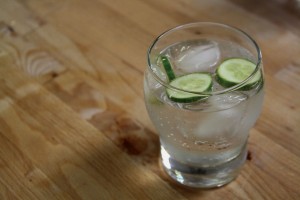If we were playing Family Feud and the question was, “Name the phrases and feelings conjured by 100 people who were asked to free associate with the liquor gin,” we can guess at the top answers on the board. “And tonic.” “Tastes like liquid Christmas.” “With my mind on my money and my money on my mind.” It’s true that aside from rubbing elbows with Snoop, gin hasn’t always had a place of prominence with Americans in recent decades. When it comes to on-trend cocktails, we’ve focused a lot on (and perhaps exhausted) bourbons. But as we all become fatigued by whiskey, a door has been left open for gin — a semi-forgotten spirit that enjoyed booming popularity in 18th century England, the roaring ’20s and now in 2018.
If we’re staying focused on the UK for a moment (And why not? In 1720, Parliament had to pass five major legislative acts just to try to curb the gin craze sweeping the country.), gin is booming. According to The Guardian, last year the British set a new record for gin purchases after buying 47 million bottles in 2017. By the end of the year, national polls had it listed as the most popular spirit at 29%, with whiskey trailing at 25% favorability.
So are we seeing any evidence of a spike in gin consumption in Rhode Island?
According to Justin Hutchins, manager at Charlestown Wine and Spirits, gin sales have increased every year. “Part of this is because of the  many gin lovers on staff, leading to some stocked shelves of really unique and terrific gins,” he explains. “However, I think the biggest reason for increased interest lies in a general trend of people looking for more authentic products. Gin, in many respects, is the original flavored vodka.”
many gin lovers on staff, leading to some stocked shelves of really unique and terrific gins,” he explains. “However, I think the biggest reason for increased interest lies in a general trend of people looking for more authentic products. Gin, in many respects, is the original flavored vodka.”
Gin is comparatively straightforward to produce, which is, perhaps, part of the reason small distilleries have been able to tackle the beverage as a target for reinvention. “People respond to the herbs and spices added to these spirits to make these fascinating gins,” Hutchins said. “Many of our favorites (at Charlestown) come from products grown or foraged in the area, giving it a sense of place. Gins are also great for making cocktails, adding their personality to a drink, unlike vodka, which is more neutral.”
It’s an obvious truth at several revered cocktail bars in the state. This past March, The Dorrance rolled out their “Greatest Hits” cocktail list, featuring the most popular drinks of the last six years. Both the Holy Spritz — a cocktail with Bar Hill Gin — and Briar Rose, featuring Damrak Gin, blackberry and Earl Grey tea syrup, lemon and Metaxa, made the cut.
Their placement on the menu proves that plenty aren’t dissuaded by the liquor’s distinct attributes and aroma.
“If you don’t like gin because you think it tastes like pine trees or other characters associated with juniper berry, there are plenty of other options out there,” says Hutchins. He recommends gins for those who may still hold doubts: “Especially in the United States, many producers create gins where the juniper is in the background, often with more fruit forward flavors dominating. The ‘New World’ gins are great for gin and tonics. Greenhook Ginsmiths is an example of one of our favorites, but Aviation is also a good example of the style. Once you try out these gins, try a basic but well made London dry style, like Boodles. In general, anything that lists itself as London Dry will be much more piney and dry in style.”
For the unacquainted, it may not be intuitive to consider gins in terms of which one is more “juniper forward” than another. If you’re unsure where to begin in your gin exploration and are ready to move beyond Beefeater and Seagram’s, you may feel a bit overwhelmed — there’s never been so many options, as Hutchins sees it. But he gives several his stamp of approval, some with New England roots.
“It’s hard to pick just one,” Hutchins says. “Barr Hill out of Vermont makes an incredible gin with honey. Gin Mare, from Spain, has a rosemary and olive presence, and a rich mouthfeel. It works great as a martini all by itself. The St. George gins might be my favorites… The Botanist is a great example of perhaps the perfect gin. We’ve also added some options closer to home. Greylock Gin is a classic, while Bully Boy is a fairly new entrant that is very tasty. Both are from Massachusetts.”
If we follow pace with the rapid growth of distilleries and the ginaissance happening in the UK, we’ll have more new entrants to sip from soon.
